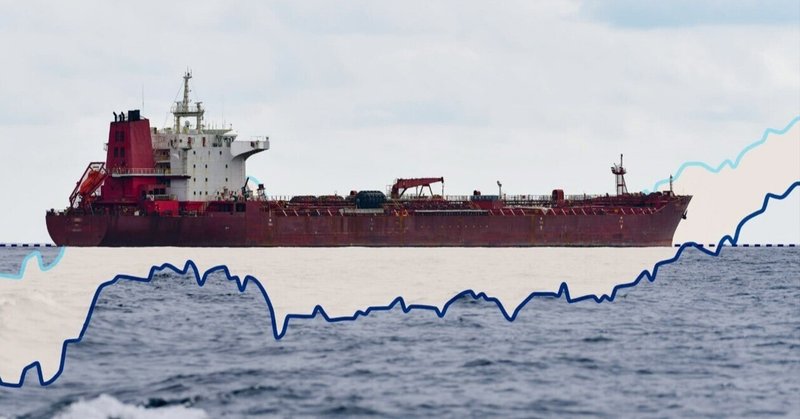
ロシア、数十億ドル規模の石油上限の抜け穴を悪用/FTを読む
Russia exploits billion-dollar oil cap loophole
ロシア、数十億ドル規模の石油上限の抜け穴を悪用
Inflated shipping costs offer opportunity to bring in more cash
送料の高騰により、より多くの現金をもたらす機会がもたらされる
Inflated shipping costs are enabling Russian companies to earn far more from crude oil sales to India than previously recognised, according to a Financial Times analysis which suggests that the charges may have raised more than $1bn in a single quarter.
フィナンシャル・タイムズ紙の分析によると、輸送コストの高騰により、ロシア企業はインドへの原油販売で以前に認識されていたよりもはるかに多くの収益を得ることができており、この料金により単一四半期で10億ドル以上が調達された可能性があることが示唆されている。
Russia has, until recently, appeared to comply on this route with western measures designed to curb its revenues which were introduced after its full-scale invasion of Ukraine last year. Its oil producers have been selling crude to India for below the $60-per-barrel price cap.
ロシアは最近まで、昨年のウクライナ侵攻の後に導入された西側の歳入抑制策を遵守してきたように見えた。その石油生産者は、1バレルあたり60ドルの上限価格を下回る価格でインドに原油を販売してきた。
But when freight costs are included, they and the traders with whom they work have charged much higher sums.
しかし、運送費を含めると、彼らと彼らが取引するトレーダーは、はるかに高い金額を請求しています。
An FT analysis of ships running directly from Russia’s Baltic ports to India suggests that this overcharging, combined with fees earned from shipping the oil on Russia-linked vessels, may have been worth $1.2bn in the three months to July.
ロシアのバルト海の港からインドに直接運航する船舶をFTが分析したところ、この過大請求と、ロシアと関係のある船舶による石油の輸送から得た手数料を合わせた金額は、7月までの3か月で12億ドル相当に達した可能性があることが示唆されている。
Benjamin Hilgenstock, an academic at the Kyiv School of Economics, which has been studying evasion of the price cap, said: “Inflated shipping costs are a major concern as they effectively create a leak in the price cap regime through which someone, somewhere can siphon off billions of dollars.”
キエフ経済大学のベンジャミン・ヒルゲンシュトック教授は、価格上限逃れを研究している: 「海運コストの高騰は、価格上限制度に事実上の漏れを生じさせ、どこかの誰かがそれを通じて何十億ドルもの金を吸い上げることができるため、大きな懸念材料となっている」。
James Cleverly, the UK’s foreign secretary, said: “It comes as no surprise that Putin is becoming increasingly desperate and dishonest in his attempts to mitigate the price cap’s impact — something that has been severely restricting Russian revenues since its introduction. Those aiding Russia’s attempts to fund this illegal war should know, the UK will continue to act alongside our partners to enforce this measure.”
英国のジェームス・クレバリー外務大臣は、「プーチン大統領がプライスキャップの影響を軽減しようとする試みにおいて、ますます絶望的かつ不誠実になっているのは驚くべきことではない。プライスキャップの導入以来、ロシアの歳入は厳しく制限されている。」と語った。 この違法な戦争に資金を提供しようとするロシアの試みを支援している人々は、英国がこの措置を執行するために我々のパートナーと協力し続けることを知っておくべきだ」。
The price cap imposed by the G7 is intended to keep Russian oil flowing while squeezing revenues that could be used to fund the war. But the cap — which places requirements on buyers, shipowners and insurers from participating countries — does not impose any limit on freight costs.
G7によって課された価格上限は、戦争資金に使用される可能性のある収入を圧迫しながら、ロシアの石油の流通を維持することを目的としています。 しかし、参加国の買い手、船主、保険会社に要件を課すこの上限は、運賃に制限を課すものではない。
Customs returns show a wide spread between Russian crude prices at Baltic ports and in India
税関申告書によると、バルト海の港とインドのロシア原油価格には大きな開きがあることが示されている
Average, highest and lowest prices reported by India and Russia per week ($ per barrel)
インドとロシアが報告する週当たりの平均価格、最高価格、最低価格(1バレル当たりのドル)
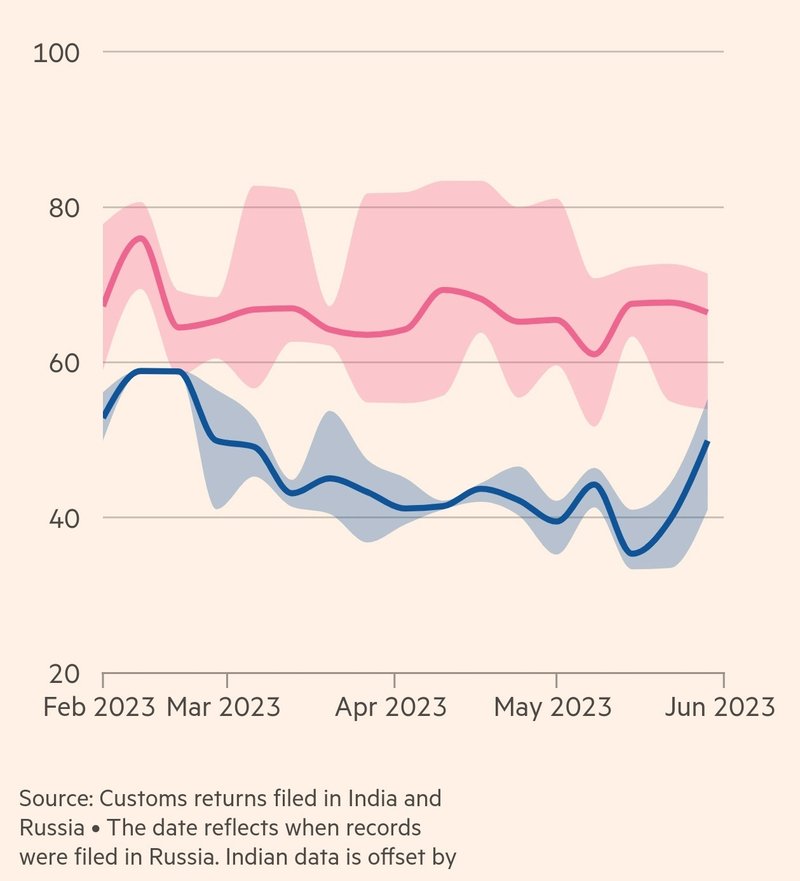
Customs records issued in Russia from December until the end of June indicate that the average price of crude oil shipped to India was around $50 per barrel in Russia’s Baltic ports. This kept the sales in line with the cap, which applies to the so-called “free on board” (FOB) price, or the cost of the oil at the port of loading.
12月から6月末までロシアで発行された税関記録によると、ロシアのバルト海の港でインドに出荷された原油の平均価格は1バレルあたり約50ドルだった。 これにより、売上高は、いわゆる「船上無料」(FOB)価格、つまり積地港での原油のコストに適用される上限に沿った水準に保たれた。
But Indian customs data shows that the prices actually being paid in India after delivery — the so-called “cost, insurance and freight” (CIF) price — over the same period had amounted to $68. This was a marked discount on world oil prices, which averaged around $79 per barrel over the period, but implies an $18 per barrel rise in prices between the Baltic and India.
しかし、インドの税関データによると、同時期にインドで配達後に実際に支払われた価格、いわゆる「実費、保険、運賃」(CIF)価格は68ドルに達していた。 これは、期間中の平均1バレルあたり約79ドルだった世界の原油価格に比べて大幅な割引であったが、バルト海とインドの間の価格が1バレルあたり18ドル上昇したことを意味している。
Figures from Argus, a pricing agency, also point to a large spread. Argus estimates that the average price of Urals crude has been $14.90 per barrel higher in India than in the Baltic since data started to be collected in February. This is in excess of Argus’s estimates of the actual price of shipping, which has averaged around $9 per barrel.
価格設定会社アーガスの数字もスプレッドが大きいことを示している。 アーガス社は、2月にデータを収集し始めて以来、インドのウラル原油の平均価格はバルト海よりも1バレル当たり14.90ドル高くなっていると推定している。 これは、Argus 社が見積もった実際の輸送価格(平均すると 1 バレルあたり約 9 ドル)を上回っています。
An official at an Indian state-owned oil company which bought some of this oil told the FT that Indian buyers were buying inclusive of shipping costs. The official said that no negotiation was allowed over freight arrangements or costs.
この原油の一部を購入したインド国営石油会社の関係者は、インドのバイヤーが輸送費を含めて購入しているとFTに語った。 同当局者は、貨物の手配や費用についての交渉は認められていないと述べた。
The Russia-India crude route ballooned to more than 60mn barrels per month
ロシア-インド原油ルートは月産6,000万バレル以上に膨れ上がった
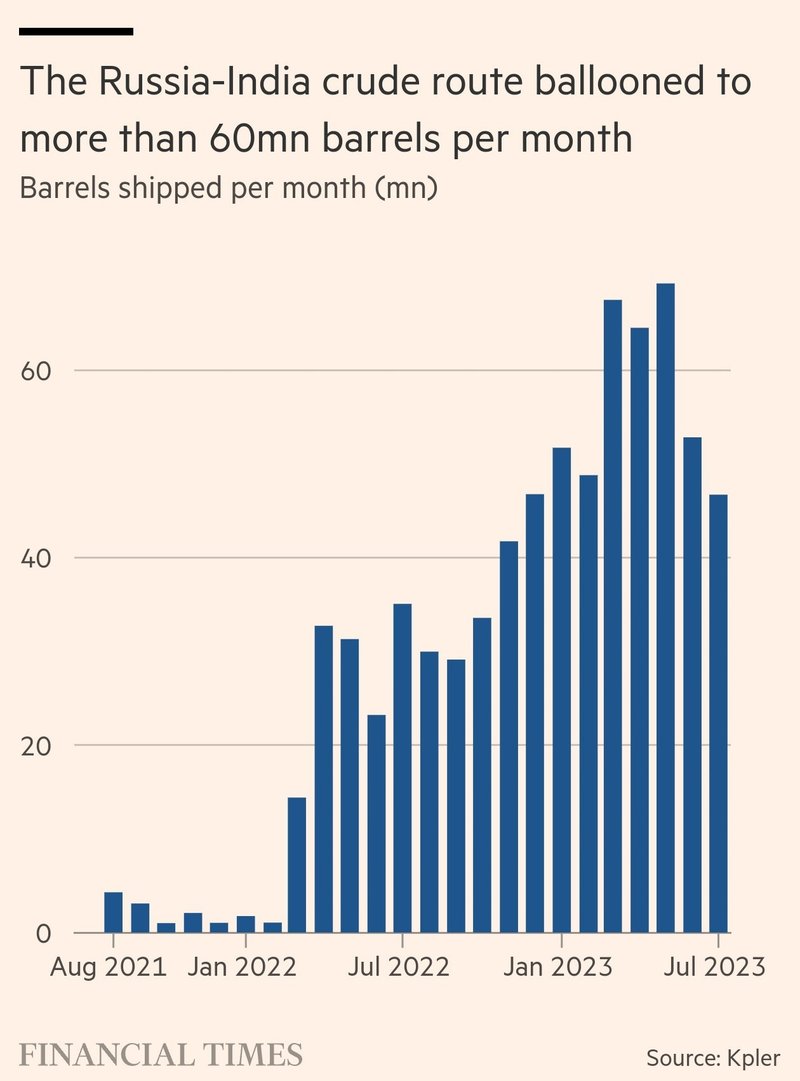
The Russia-India crude route ballooned tThe excess charges are therefore likely to have been captured by the sellers of the oil. According to Kpler, the data analytics company, the oil producers Lukoil and Rosneft have made direct sales to Indian refineries. In other cases, the sale is managed by trading companies that have emerged in the past year with close links to several Russian oil companies.
したがって、超過料金は石油の売り手に徴収された可能性が高い。 データ分析会社Kplerによると、石油生産会社ルクオイルとロスネフチはインドの製油所に直接販売を行っている。 他のケースでは、ロシアの石油会社数社と密接な関係を持つ過去1年に浮上した商社が売却を管理している。
Kpler estimates that Russia shipped 108mn barrels from the Baltic to India from May to July in 134 vessels, a time when the spread between Argus prices averaged $17 per barrel, after taking account of the lag between departure and delivery. At that time, Argus estimates that commercial shipping rates averaged $9 per barrel, suggesting that the overcharging may be worth around $800mn.
クプラー社は、ロシアが5月から7月にかけて134隻の船でバルト海からインドに1億800万バレルを出荷したと推定しており、出発と引き渡しまでのラグを考慮すると、この時期のアルガス価格間のスプレッドは平均1バレル当たり17ドルであった。 当時の商業輸送料金は平均1バレル当たり9ドルだったとアーガスは推定しており、過剰請求は約8億ドルの価値がある可能性があることを示唆している。
Hilgenstock said: “If Russian oil companies and traders agree to these kind of contractual conditions, we have to assume that a portion of the spread is being captured by Russia — whether or not Russia owns the tankers moving the oil.”
ヒルゲンシュトック氏は、「ロシアの石油会社やトレーダーがこの種の契約条件に同意するのであれば、石油を輸送するタンカーをロシアが所有しているかどうかに関係なく、スプレッドの一部はロシアによって捕獲されていると想定しなければならない」と述べた。
Russia does have a hand in the tanker fleet. Of the 134 vessels identified by Kpler as moving Russian oil to India from May to July, the FT has been able to directly link 23 of them to Russian entities via insurance, ownership or management documentation.
ロシアはタンカー艦隊に関与している。 5月から7月にかけてロシアの石油をインドに輸送したとクプラーが特定した134隻の船舶のうち、FTは、保険、所有権、管理書類を通じて、そのうち23隻をロシアの事業体と直接結び付けることができた。
Most of these are run by Sun Ship Management, which has been placed under sanctions by the UK and EU for being connected to Sovcomflot, the giant Russian state tanker fleet.
これらのほとんどはサン・シップ・マネージメントによって運営されており、同社はロシアの巨大国営タンカー船団であるソフコムフロットと関係しているとして英国とEUから制裁を受けている。
The shipping loophole is potentially worth billions of dollars
輸送の抜け穴には数十億ドルの価値がある可能性がある
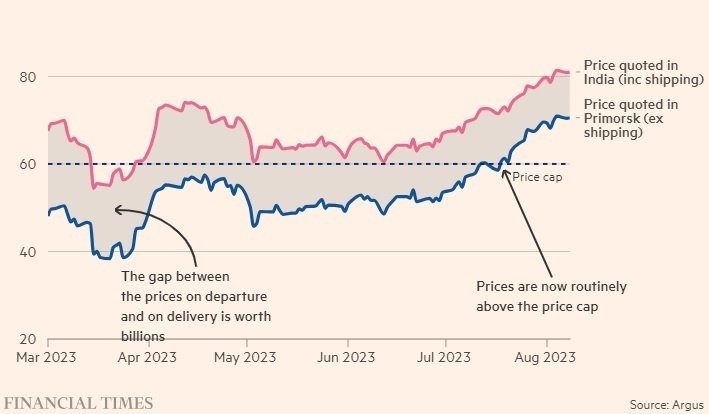
The FT has identified a further 26 “ghost” vessels which were bought by their current owners since the start of the war. Their owners are secret, hidden via shell companies largely in the Marshall Islands and Liberia, but all have dramatically diverted on to the Russian oil routes since being bought — and some have previously been linked to Russia.
FTは、戦争開始以来、現在の所有者によって購入された「幽霊」船をさらに26隻特定した。 それらの所有者は秘密で、主にマーシャル諸島とリベリアのダミー会社を通じて隠蔽されているが、買収されてからすべてが劇的にロシアの石油ルートに転向しており、一部は以前にロシアと関係があった。
In the three months to July, around 40 per cent of the oil shipped from the Baltic was carried by the Russia-connected fleet. The freight cost estimates calculated by Argus imply that this fleet may have earned more than $350mn in revenue on the route over the quarter.
7月までの3カ月間で、バルト海から輸送された石油の約40%がロシアとつながった艦隊によって運ばれた。 アーガスが計算した運賃の見積もりは、この艦隊が同四半期にこの路線で 3 億 5,000 万ドル以上の収益を上げた可能性があることを示唆している。
Adding the $800mn by which fees were inflated, this means that Russian entities may have covertly made a billion dollars more in revenue over that period than previously recognised.
手数料がつり上げられた8億ドルを加えると、これはロシア企業がその期間にこれまで認識されていたよりも密かに10億ドル以上の収益を得ていた可能性があることを意味する。
India now accounts for around a quarter of Russia’s crude and refined oil exports. Russia’s global oil exports amounted to $39bn in total over these three months, according to the International Energy Agency.
インドは現在、ロシアの原油および精製油輸出量の約4分の1を占めている。 国際エネルギー機関によると、ロシアの世界の石油輸出は、この3か月で総額390億ドルに達した。
Keeping the price in its Baltic ports below the price cap had allowed Russia to also use ships with western insurance. More than half of the vessels on the route during that quarter were G7-insured, with 46 of them run by Greek ship managers.
バルト海の港での価格を上限価格以下に抑えることで、ロシアは西側の保険が適用された船舶を使用することも可能になった。 同四半期に航路を航行した船舶の半数以上がG7保険に加入しており、そのうち46隻はギリシャの船舶管理者によって運航されていた。
Greek-domiciled ship managers pulled back from Russia-India route in July
ギリシャ籍の船舶管理会社、7月にロシア-インド航路から撤退
Millions of barrels moved per month, based on given postal address of ship manager
船舶管理者の指定された住所に基づいて、毎月数百万バレルが移動されました
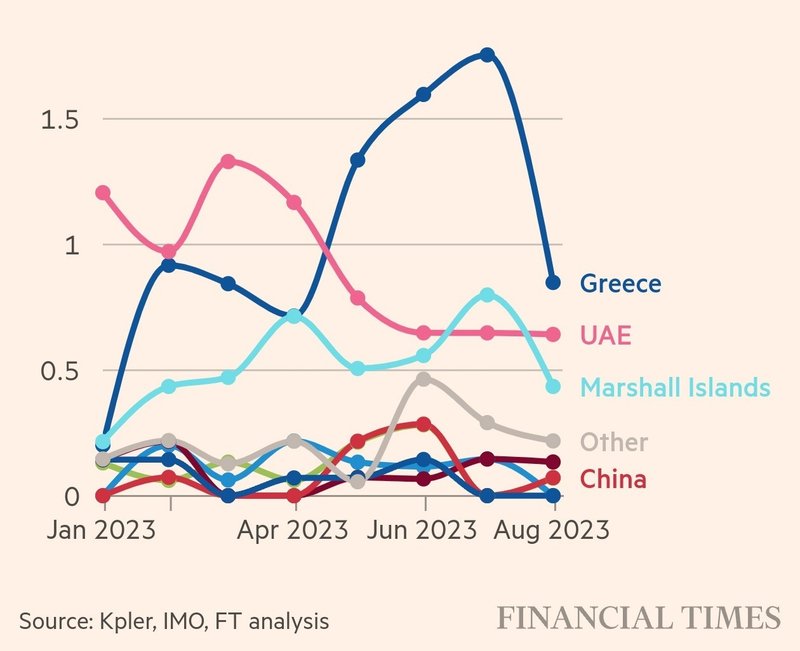
Millions of barrels moved per month, based on given postal address of ship manager
船舶管理者の指定された住所に基づいて、毎月数百万バレルが移動されました
The number of western vessels is dropping, however — a consequence of international crude prices rallying 15 per cent in the past month to near $85 a barrel. This has dragged Russian prices higher and closer to the cap. Argus has assessed that average quoted prices in Primorsk, a major Baltic port, rose above $60 last month.
しかし、西側の船舶数は減少しており、これは国際原油価格が過去1ヶ月で15%上昇し、1バレル85ドル近くまで上昇した結果である。その結果、ロシアの価格は上昇し、上限まで近づいている。アーガスは、バルト海の主要港であるプリモルスクの平均相場が先月60ドルを超えたと評価している。
This makes it more difficult for western-linked companies to shift the oil while still obeying the cap. As a result, Greek-domiciled ship managers suddenly started to leave the Russian crude market in July.
このため、欧米の関連企業は、上限を守りつつ原油をシフトすることが難しくなった。その結果、ギリシャ籍の船舶管理会社は7月に突然ロシア原油市場から撤退し始めた。
The International Energy Agency said on Friday that Russia’s oil export revenues in July reached their highest level since the cap was introduced, even without including inflated freight costs.
国際エネルギー機関は金曜日、7月のロシアの石油輸出収入は、高騰した運賃を除いても上限導入以来最高水準に達したと発表した。
The higher prices may also deter buyers, however. An Indian oil official told the FT that the discount was now just $2 to $10 a barrel.
ただし、価格が高いと購入者が躊躇する可能性もあります。 インド石油当局者はFTに対し、割引額は現在1バレル当たり2─10ドルにすぎないと語った。
“Indian imports may now decline, as the discounts aren’t as generous,” said Amrita Sen at Energy Aspects. “Their banks are also getting anxious now there are signs that most cargoes are trading above the price cap.”
エネルギー・アスペクツのアムリタ・セン氏は「割引がそれほど寛大ではないため、インドの輸入は今後減少する可能性がある」と述べた。 「ほとんどの貨物が価格上限を超えて取引されている兆候が見られる今、彼らの銀行も不安を感じています。」
英語学習と世界のニュースを!
自分が関心があることを多くの人にもシェアすることで、より広く世の中を動きを知っていただきたいと思い、執筆しております。もし、よろしければ、サポートお願いします!サポートしていただいたものは、より記事の質を上げるために使わせていただきますm(__)m
